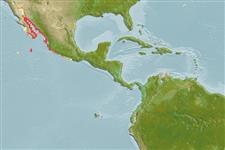Issue
Type locality: Baja California Sur, Inner Gorda Bank, 23°02'N, 109°31'W.
Environment: milieu / climate zone / depth range / distribution range
Écologie
marin récifal; profondeur 8 - 55 m (Ref. 58018). Tropical; 33°N - 14°N, 115°W - 98°W (Ref. 5222)
Eastern Central Pacific: Gulf of California south to Jalisco, Mexico.
Taille / Poids / Âge
Maturity: Lm ? range ? - ? cm
Max length : 105 cm TL mâle / non sexé; (Ref. 40637); poids max. publié: 14.1 kg (Ref. 40637)
Description synthétique
Clés d'identification | Morphologie | Morphométrie
Épines dorsales (Total) : 11; Rayons mous dorsaux (Total) : 16 - 18; Épines anales: 3; Rayons mous anaux: 10 - 12. Distinguished by the following characteristics: adults with pale grey to brown with purplish tint underwater; body, median fins and rear part of the head covered with small dark reddish brown spots; faint irregular dark spots on dusky pectoral and pelvic fins; dusky blotches on the dorsolateral part of the body; angular preopercle, with serrate lobe at the angle; posterior nostrils not greatly enlarged in adults; rear margin of caudal fin scalloped, with exserted rays (Ref. 89707).
Found on rocky reefs. Common on fields of large boulders with gorgonians and black corals. Feeds on fishes and crustaceans (Ref. 89707).
Life cycle and mating behavior
Maturité | Reproduction | Frai | Œufs | Fécondité | Larves
Heemstra, P.C. and J.E. Randall, 1993. FAO Species Catalogue. Vol. 16. Groupers of the world (family Serranidae, subfamily Epinephelinae). An annotated and illustrated catalogue of the grouper, rockcod, hind, coral grouper and lyretail species known to date. Rome: FAO. FAO Fish. Synop. 125(16):382 p. (Ref. 5222)
Statut dans la liste rouge de l'IUCN (Ref. 130435: Version 2024-1)
Menace pour l'homme
Harmless
Utilisations par l'homme
Pêcheries: pêcheries vivrières
Outils
Articles particuliers
Télécharger en XML
Sources Internet
Estimates based on models
Preferred temperature (Ref.
123201): 19.8 - 27.4, mean 22.9 °C (based on 30 cells).
Phylogenetic diversity index (Ref.
82804): PD
50 = 0.5000 [Uniqueness, from 0.5 = low to 2.0 = high].
Bayesian length-weight: a=0.00933 (0.00426 - 0.02047), b=3.05 (2.88 - 3.22), in cm total length, based on LWR estimates for this Genus-body shape (Ref.
93245).
Niveau trophique (Ref.
69278): 4.4 ±0.8 se; based on size and trophs of closest relatives
Résilience (Ref.
120179): Très faible, temps minimum de doublement de population supérieur à 14 ans (Preliminary K or Fecundity.).
Fishing Vulnerability (Ref.
59153): High vulnerability (63 of 100).
Nutrients (Ref.
124155): Calcium = 20.9 [13.1, 36.4] mg/100g; Iron = 0.455 [0.250, 0.763] mg/100g; Protein = 18.7 [16.8, 20.3] %; Omega3 = 0.127 [0.084, 0.197] g/100g; Selenium = 39.1 [21.5, 72.4] μg/100g; VitaminA = 108 [38, 346] μg/100g; Zinc = 0.766 [0.534, 1.079] mg/100g (wet weight);
